|
|
|
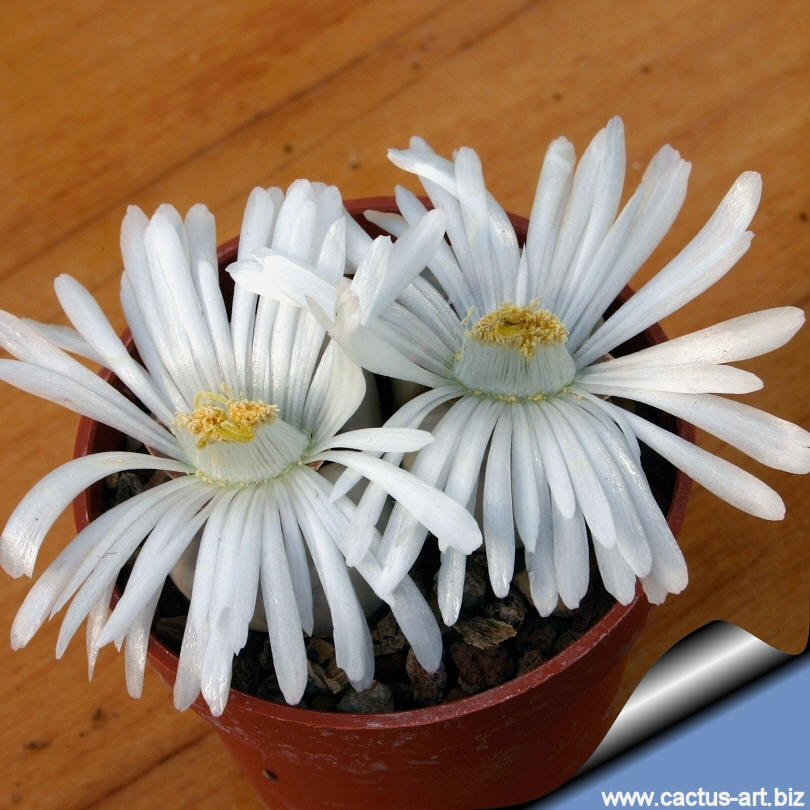
Lithops julii
|
Description:
Lithops julii is a stemless small to medium sized
cone-shaped pair of leaves that are separated by a 5-10 mm deep fissure
with (usually) conjunct lobes. It is usually whitish-grey to dark grey
but very variable in colour, some specimens being opaque whitish-grey
and almost uniform in colour, others opaque but strongly reticulated
with fine impressed brown markings, yet others with largely open
obscurely transluscent windows. The profile is truncate, the tops are
flat to slightly convex. Face slightly reniform.
Flowers: It produces a single white daisy-like flower emerges
from the fissure and is as large as the pair of fleshy leaves below.
Blooming season: From mid-summer through fall
Fruit: Seed capsules-loculetd.
Seeds: Yellow-brown to light yellow-brown
Lithops julii comprises several more or less intergrading
and distinct subspecies and variety:
-
subsp. julii
(Dint. & Schwant.) N.E. Br. 1925 - Cole numbers: C063,
C064, C183, C297, C349 (chrysocephala) C205; (littlewoodii) C218.
The more distinctive feature of this plant is a brown 'lip-smear'
along the inner margins. The lip-smear occurs occasionally as a narrow
edging or lining all along the outer margins. The windows are more or
less occluded with irregular broad and distinct channels, often
obscure or reduced to a network of narrow, grooves. The channels have
often a very variable network of rubrications and lines. Islands are
large more or less distinct against the background of opaque channels.
Shoulders, margins and islands are whitish grey, sometimes tinged with
blue, mauve or pink. Windows and channels are grey-white with some
blue, mauve, pink, beige or brown or slightly translucent greenish
grey, greenish or yellowish brown. Margins rather obscure irregularly
dentate or sinuate, with a number of peninsulas.
Three main forms have been proposed and were even given varietal
status (“pallid”,
“reticulated”
and
“fuscous”)
but wild populations tend to have at least two and many have all three
of this forms variously intermingled . Distribution: Namibia
-
subsp. fulleri
(N.E. Br) B. Fearn 1927 -
Cole numbers:
C024, C056, C062, C121, C122, C161, C162A, C171, C203,
C230B, C259, C319, C323, C378
This is an extremely variable subspecies in colour, pattern and
rubrication. Face somewhat unequal, margins distinct irregularly
dentate, sometimes sinuate with quite large peninsulas; both inner and
outer margins usually edged with a brown lining.
Windows distinct
occasionally reduced to a network of narrow grooves. Channels slightly
impressed. Islands regular in shape more or less large; usually
distinct. Rubrications appear in the marginal indentations, as a
series of marks. Shoulders, margins and islands light grey, often
tinged with pink, yellow, blue or green, or beige. Windows and
channels milky blue, pale pinkish, greenish or yellowish grey, or
mauve, pink or rust-brown; often with a brown or dark greenish-brown
smear thinly lining both inner and outer margins.
-
subsp. fulleri
var. brunnea H.W. de Boer 1962 - Cole number: C179
Very similar to var. fulleri, but browner in colour. Colours:
Shoulders, margins and islands pale creamy, pinkish or bluish grey, or
beige. Windows and channels greyish, reddish or greenish brown, or
grey. Rubrications red.
-
subsp. fulleri
var. rouxii (H.W. de Boer) D.T. Cole 1964 - Cole numbers:
C215, C216, C217, C324
Strictly related to var. fulleri, but marked with stitch-like marginal
rubrications. Margins with irregular indentations,and a distinctive
series of dark rubrications which resemble stitches.
Cultivars:
-
subsp. julii cv.
'Peppermint Crème' 1999 Cole number: C297A
Very distictive blue-green form derived from only one specimen
collected by Leslie Pretorius in 1983 in Namibia. Margins and islands
very pale milky bluish green and shoulders a little lighter than the
margins. Lip-smears pale brownish green. Channels opaque pale milky
bluish grey.
-
subsp. fulleri
var. fulleri cv. 'Fullergreen' 1988 Cole number: C056A.
Shoulders, margins and islands light creamy greenish grey, margins
edged with a light brownish-green, especially in the indentations.
Windows and channels opaque greyish blue-green. Rubrications obscure
dark red-brown.
|
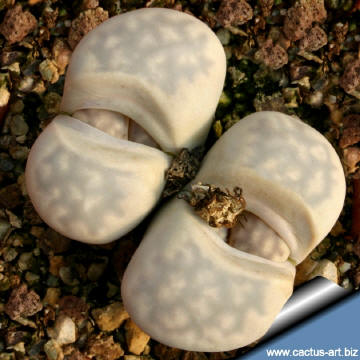
Lithops julii ssp. julii C297
(pale whitish-grey form) |
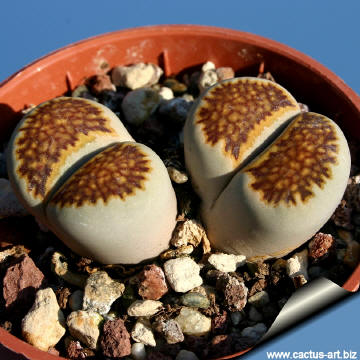
Lithops julii "fuscous" (brown form) |
|
Advertising
|
|
|
|
Family: Mesebrianthemaceae (Aizoaceae)
Scientific name: Lithops julii
subsp. julii
(Dint.&Schwant.) N.E. Br. 1925
"pallid"
Origin: Namibia
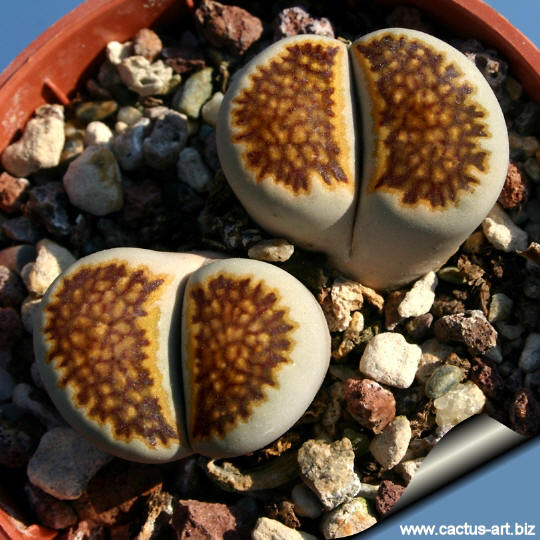
Lithops julii "fuscous" (brown form)
|
|
|
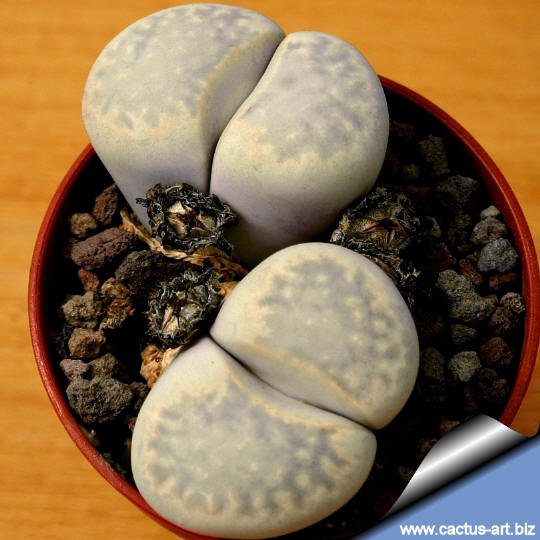
Lithops julii "pallid" SB1344
Remarks: Lithops are partly
subterranean, with only the clear 'window'
in each leaf tip exposed above soil. A type of optical system exists
whereby a layer of apical tissue rich in calcium oxalate crystals acts
as a filter to intense sunlight before it reaches the thin
chlorophyllous layer below. They are also called
mimicry plants as they show a striking similarity to their
background rocks and are difficult to detect when not in flower. These
are the commonly known as pebble plants or living stones; each species
is associated with one particular type of rock formation and occurs
nowhere else. Its soil-embedded, subterranean growth form also reduces
the need for chemical defences against herbivores.
Cultivation: L. hookeri is a summer growing species with dry rest
period over winter. Easy to grow it tolerates a degree more excess water
than some particular hydrophobic species, even so it must have a very
open mineral, fast draining mix with little compost and a high degree of
grit, coarse sand, small lava gravel or pebbles. Give them the maximum
amount of light you are able to give them, but care should be taken
about exposing them to the full blast of the sun rays in summer. Such
tiny plants can easily get scorched or broiled and their appearance
spoiled (this may not matter in the wild, where the Lithops have
probably shrunk into the ground and becomes covered with sands).
The basic cultivation routine is: Stop watering after flowering. Start
watering after the old leaves completely dry. (Usually late March or
Early April) Water freely during the growing season, soak the compost
fully but allow it to dry out between waterings, no water when
cold. Some growers fertilize frequently, some hardly
ever. Keep them dry during the winter. Nearly all problems occur as a
result of overwatering and poor ventilation especially when weather
conditions are dull and cool or very humid. If too much water is
supplied the plants will grow out of character, bloat, split and rot.
Keep them in small pots as solitary clumps or as colonies in large,
shallow terracotta seed pans.
Note: After flowering in the
autumn and extending through
winter
season the plant doesn’t need
watering, but they will still be
growing, the new
bodies will be increasing in size extracting
water from the outer
succulent leaves, allowing them to
shrivel away. In fact the plant in this time extracts
water and
nutrient stored in the outer
succulent leaves, allowing them to
dehydrate relocating the water to the rest of the plant and to
the new leaves that form during this period until the old leaves are
reduced to nothing more than "thin papery shells".
Photo of conspecific taxa, varieties, forms and cultivars of
Lithops julii.


|
|